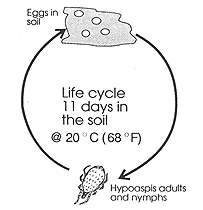|
A Comprehensive Guide to Safe Biological Pest Control |
* Ask a Question * |
| Home About FAQ Quick Reference | |
NATURAL PEST CONTROL WITH HYPOASPIS

THE PREDATORY SOIL MITE....
Hypoaspis miles feed upon small, soil inhabiting insects, mites, and all stages of springtails. Is primary a predator of fungus gnat larvae in the soil, but it also consumes thrips pupae on the floor and soil surface of the greenhouse. It is a scavenger and can feed on soil debris in the asence of thrips pupae and fungus gnat larvae. They are a native soil mite and can adapt to a variety of different growth media and capillary mats. They are less than 1 mm (1/20 inch) in size, light brown in color, and can be seen moving quickly on the soil surface and base of plants. Hypoaspis are used primarily for control of fungus gnats, but they also help with western flower thrips control.
 Populations of Hypoaspis include both sexes, but the males are much smaller and rarely seen. Under a hand lens most stages of this mite look similar. Hypoaspis inhabit the top few centimeters (inch) of soil only. Eggs hatch in about 2-3 days, and the life cycle is completed in about 11 days. These predatory mites feeds upon the young larvae of fungus gnats in the soil, and are most effective when applied to soil before fungus gnat populations are establised. Hypoaspis consume 1-5 prey per day and can survive as a scavenger by feeding on algae and plant degris. Hypoaspis tolerate a variety of conditions except flooding. They can survive mild winters but are inactive below 57 degrees F.
Populations of Hypoaspis include both sexes, but the males are much smaller and rarely seen. Under a hand lens most stages of this mite look similar. Hypoaspis inhabit the top few centimeters (inch) of soil only. Eggs hatch in about 2-3 days, and the life cycle is completed in about 11 days. These predatory mites feeds upon the young larvae of fungus gnats in the soil, and are most effective when applied to soil before fungus gnat populations are establised. Hypoaspis consume 1-5 prey per day and can survive as a scavenger by feeding on algae and plant degris. Hypoaspis tolerate a variety of conditions except flooding. They can survive mild winters but are inactive below 57 degrees F.
Hypoaspis are for preventative control only, before fungus gnat populations are high. They are supplied in a peat mixture in one liter containters and should be aplied as soon as they are recieved, but can be held at room temperature for limited periods if absolutely necessary. Introduce 1-2 litres per acre for greenhouse vegetables and 1 liter per 1000 square feet for bedding plants.
